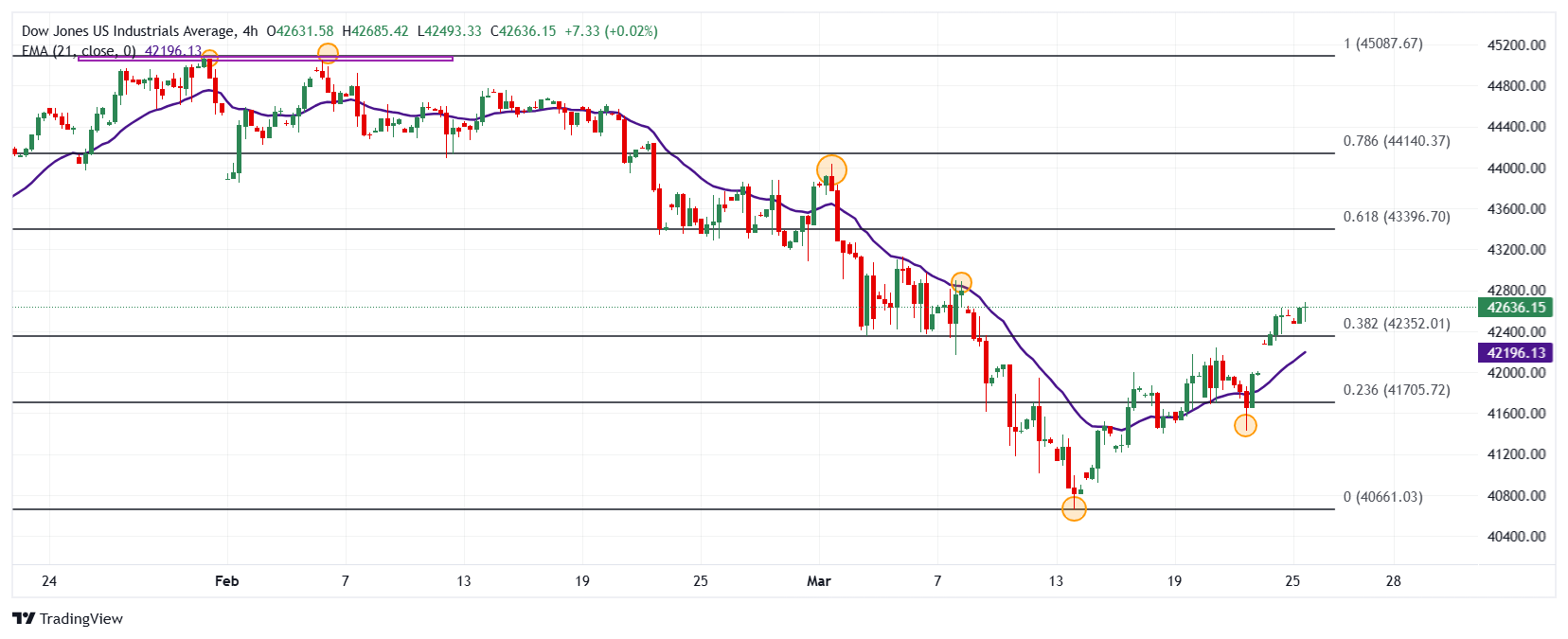- The Dow Jones rises 0.22% daily, reaching maximums of March 7 at 42,685.
- The Nasdaq 100 wins 0.51% today, animated by Crowdstrike Holdings (CRWD).
- The S&P 500 rebounds 0.29% in the day, led by International Paper Company (IP)
- The Conference Board Conference Conference Index fell to 92.9 in March, registering its weakest reading since February 2021.
- President Donald Trump reduced commercial tensions yesterday by announcing a possible tariff exemption to several countries.
The Dow Jones marked a daily minimum in 42,479, finding buyers who took the index to a maximum not seen from March 7 in 42,685.
The Dow Jones industrial average began operating at 42,501 while the Nasdaq 100 technological index began negotiations in 20,143. The S&P opened in 5,755, extending its profits in tune with the main share rates.
Apple and Walt Disney lead the profits in Dow Jones
The Dow Jones index wins 0.22% today, going up 102 points until reaching maximums not seen from March 7 at 42,685.
Apple’s titles (AAPL) rise 1.26% daily, reaching maximum of March 11 at 223.90 $, signing its third consecutive day with profits.
In the same tune, Walt Disney (Dis) shares rebound 1.34% on Tuesday, exceeding March 11 in 101.55 $.
In this scenario, Dow Jones extends its profits pointing to the key resistance located in 44,000, maximum of March 3.
The Nasdaq 100 is quote on positive terrain animated by Crowdstrike Holdings and The Trade Desk
The Nasdaq 100 technological index rises 0.51% daily, currently contributing to 20,255.
Crowdstrike Holdings (CRWD) values have a gain of 3.99% on Tuesday, reaching maximums not seen since March 4 at 392.69 $, signing two consecutive days with profits. Following the upward perspective, the shares of The Trade Desk (TTD) rebound 3.49% today, visiting maximum of March 11 in 61,64 $, spinning five consecutive sessions upward.
The buying pressure promotes the Nasdaq 100 to maximums not seen from March 6 in 20,288, after the relaxation of the tariff tensions caused by the commercial rhetoric of Donald Trump.
The S&P 500 reaches maximum of almost three weeks after relaxation in commercial tensions
Donald Trump, president of the United States, said yesterday that he is willing to exempt several countries in the tariffs scheduled for April 2, causing generalized optimism in financial markets.
According to the information published by the Conference Board, the consumer confidence index fell into 92.9 points in March from 98.3 observed in the previous month. This reading is the weakest recorded since February 2021.
On the other hand, the housing price index rose 0.2% in January, complying with the expectations of analysts, although below 0.5% registered the previous period.
International Paper Company (IP) titles are triggered by 6.80% daily, reaching maximums not seen since March 3 in 56.64 $.
In this context, the S&P 500 has a 0.29% gain today, reaching maximum of almost three weeks not seen since March 6 in 5,784.
Technical Analysis of Dow Jones
The Dow Jones reacted upwards from a short -term support given by the minimum of March 21 in 41,431. The following key support is observed in 4,660, pivot point of March 13. Upwards, the closest resistance is found in 44,033 maximum of March 3.
4 -hour graph of Dow Jones

Dow Jones Faqs
The Dow Jones Industrial Avenge, one of the oldest stock market indexes in the world, consists of the 30 most negotiated values in the United States. The index is weighted by the price instead of capitalization. It is calculated by adding the prices of the values that compose it and dividing them by a factor, currently 0.152. The index was founded by Charles Dow, also founder of the Wall Street Journal. In recent years it has been criticized for not being sufficiently representative, since it only follows 30 companies, unlike broader rates such as S&P 500.
There are many factors that promote the Dow Jones Industrial Average (DJIA) index. The main one is the added performance of the companies that compose it, revealed in the quarterly reports of business benefits. The American and world macroeconomic data also contribute, since they influence investor confidence. The level of interest rates, set by the Federal Reserve (FED), also influences the DJia, since it affects the cost of credit, on which many companies depend largely. Therefore, inflation can be a determining factor, as well as other parameters that influence the decisions of the Federal Reserve.
Dow’s theory is a method to identify the main trend of the stock market developed by Charles Dow. A key step is to compare the direction of the Dow Jones Industrial Avenge (DJIA) and the Dow Jones Transportation Average (DJTA) and just follow the trends in which both move in the same direction. The volume is a confirmation criterion. The theory uses elements of maximum and minimum analysis. Dow’s theory raises three phases of the trend: accumulation, when intelligent money begins to buy or sell; Public participation, when the general public joins the trend; and distribution, when intelligent money abandons the trend.
There are several ways to operate with the DJ. One of them is to use ETF that allow investors to negotiate the DJ as a single value, instead of having to buy shares of the 30 companies that compose it. An outstanding example is the SPDR Dow Jones Industrial Avenge ETF (day). Future contracts on the DJ allow the specular operators about the future value of the index and the options provide the right, but not the obligation, to buy or sell the index at a predetermined price in the future. Investment funds allow investors to buy a part of a diversified portfolio of DJ values, which provides exposure to global index.
Source: Fx Street
I am Joshua Winder, a senior-level journalist and editor at World Stock Market. I specialize in covering news related to the stock market and economic trends. With more than 8 years of experience in this field, I have become an expert in financial reporting.







